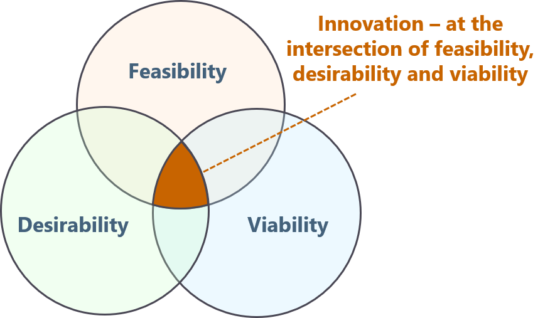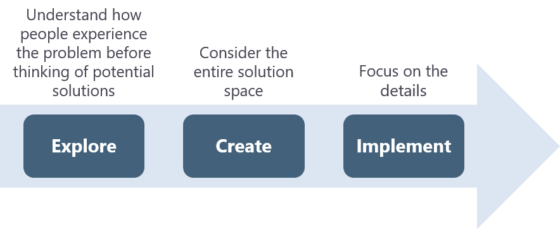APPLYING DESIGN THINKING
There is no single definition for design thinking. It is an approach or method for creative problem solving. The design thinking approach is powerful in that it can be used to solve a wide range of challenges; from new product development, to the design of an operational support process, to the focus of this paper – a specific use case related to the prioritization of data delivery.
Design thinking can be thought of and applied as a systematic innovation process which helps ensure the desirability of the solution set, the viability of the business and support model, and the feasibility of the technology solution.
DESIGN THINKING FOUNDATION

Another way to think of this foundation is to ask these questions:
- Desirability – Are we solving the right problem? Do we truly understand the pain points
- Viability – Will we be able to support the solution during the short and long terms, both financially and operationally?
- Feasibility – Will we be able to technically deliver the design with the resources we have?
Design thinking is most effective when applied alongside a repeatable process of explore, create and implement; and it is important to note, is supported by a set of critical skills that are employed throughout.
DESIGN THINKING PROCESS AND CRITICAL THINKING SKILLS

EXPLORE: PUTTING CUSTOMERS’ NEEDS AT THE HEART OF THE PROCESS
Understanding your customers’ needs in developing any product and innovative process is critical to the success of the solutions. Traditionally customer input was considered in the product development process by simply taking what the customer said at face value, sometimes referred to as ‘Voice Of the Customer’ (VOC). Design thinking elevates the customer to the center of the process. It employs an empathetic approach to truly understand their needs. Empathy, in this context, can be defined as a “deep understanding of the problems and realities of the people you are designing for”1. The design thinking approach also considers the customers’ broader needs. This helps ensure solutions not only solve specific near-term challenges but are also flexible and aware enough to be able to address future needs.
CREATE: DESIGNING WITH A FOCUS ON CUSTOMER SERVICE
The design thinking approach is not just for developing physical consumer products. It supports innovating processes, services and systems as well. Design thinking guides the project team to consider the end customers’ needs, as well as how to best integrate the operational delivery process. For example, designing a solution that supports data management or delivery of data to end customers does not require a significant departure from the design thinking approach for a tangible product. It simply requires also considering the larger service cycle and how it is decomposed into detailed customer actions or potential requirements.
IMPLEMENT: DELIVERING VALUE
Before a project moves into implementation – the costliest phase – it is important to be confident the product development process has adequately validated the desirability (solution), viability (business) and feasibility (technical) of the product or service. Whether the development method is Staged, Spiral or Agile, the design thinking process provides the framework to help ensure that money spent on implementation is not wasted. Iterative feedback from stakeholders, coupled with strong project management, provide the best chance to fully-leverage the early innovation design thinking process stages.
PUTTING IT ALL TOGETHER
“If I had asked people what they wanted, they would have said faster horses.” – Henry Ford
A question like this may be a decent starting point, but by leveraging design thinking the project team is able to dig deeper into customers’ comprehensive needs, including latent needs which help truly define a complete and valuable solution. Applying a design thinking approach in conjunction with the disciplined process of explore, create and implement drives a team to surpass initial and traditional solutions to arrive at a human-centered problem statement, ideas, alternative points of view, prototypes, experiments and ultimately solutions that are desirable, viable and feasible. Additional steps to fully-identify and deliver best-in-class solutions include:
- Staying engaged throughout the solution lifecycle – from the initial discovery of customer needs, throughout the design and deliver phases
- Leveraging investment industry expertise
- Employing sound project management disciplines
DESIGN THINKING USE CASE: PRIORITIZING DATA DOMAIN DELIVERY
The question, “Which data domains should we tackle first?” frequently arises when organizations:
- Transition from being accounting-centric to data-centric
- Implement new enterprise data management platforms
- Undertake projects to improve their existing data management structures
Working with the business, the answer can be approached empirically, identifying how many users benefit from a given data set – the degree to which a data set is truly enterprise or shared data. Alternatively, the answer may be approached by quantifying how resolving challenges with a data set will increase operational efficiency or reduce risk – prioritizing based on the return on investment. These are undoubtedly important points to help prioritize work efforts; however, they can seem like dry or artificial measures to the data customers who are focused on their own needs. If a design thinking approach is applied in parallel with empirical and quantified data, then the question, “What jobs does this data set do for us as an organization?” can be answered.
The winning combination helps prioritize an approach and helps all business stakeholders understand why the priorities are set as they are. The combination can transform a basic statement like, “Portfolio details (names, base currency, etc.) along with NAV derived figures of total assets and performance are required by many internal and external users” to more valuable statements such as:
- “The most important job the data does is to describe the performance of our organization’s products, processes and/or services to the outside world.”
- “The second most important job the data does is to compare our organization’s performance to that of the marketplace.”
- “This is how the performance was generated.”
Focusing on the jobs the data can do makes it easier to prioritize those jobs in an order that makes sense to the business. Only after prioritizing the jobs the data can do, the next step is to approach the specific data domains required to accomplish those jobs.
Considering the outcomes of the jobs allows for alignment with business-focused priorities. There are commonalities between empirical and design thinking approaches such as the project team knows the subject matter, and they can predict the order of key priorities. Design thinking adds value by helping to refine these aspects, and to clearly state the reasoning behind the priorities – especially when the order of priorities conflicts with quantitative scoring indicators.
HOW MERADIA CAN HELP
When it’s important to consider your customers’ experience with your products, processes and systems, the value they deliver, and how they solve pain points; Meradia can bring a comprehensive toolkit to solve business and technology challenges including proven methodologies and skills to:
- Apply design thinking principles appropriately
- Develop a data, performance and reporting strategy
- Identify appropriate vendor partners, tools and platforms
- Integrate and transition to production
1 IDEO’s Human-Centered Design Toolkit
Download Thought Leadership Article Solution Design Data and Technology Asset Managers Meradia Consultant info@meradia.com
info@meradia.com


